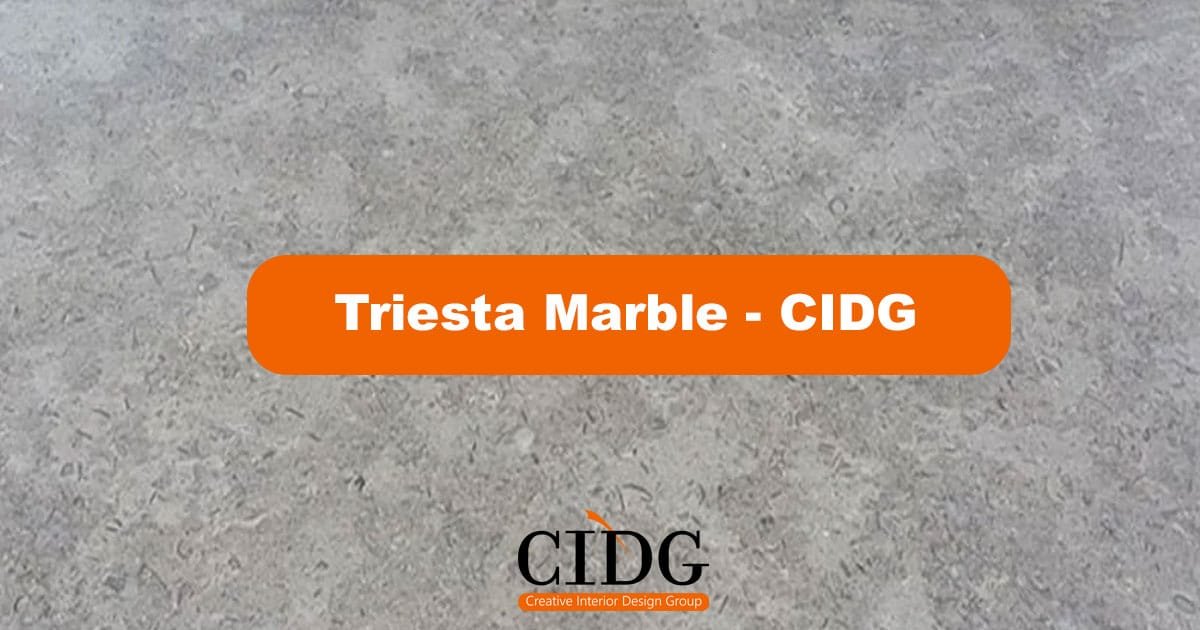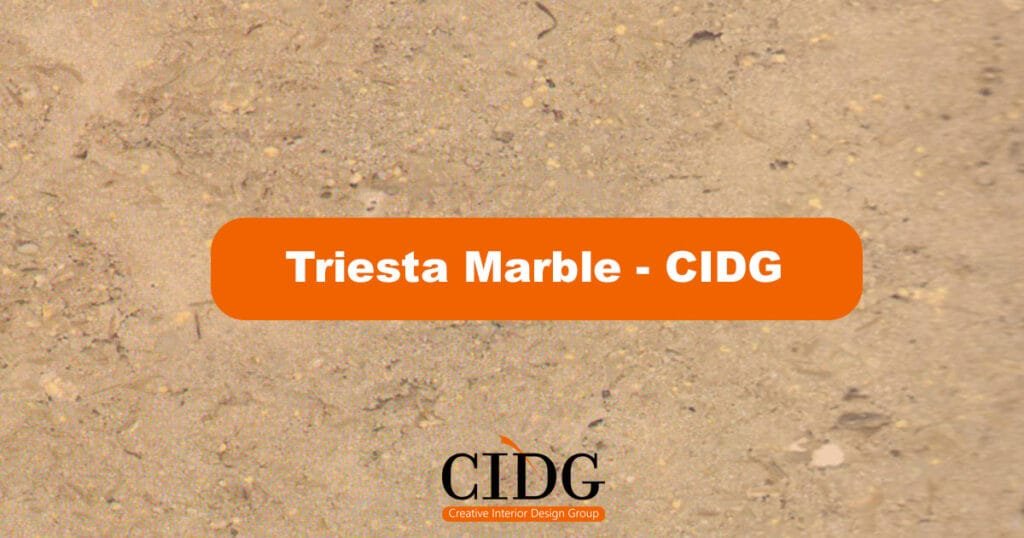When designers talk about Egyptian marble, Triesta Marble is almost always on the list. It’s the warm, welcoming stone with beige-to-sandy tones and a soft, natural texture that makes spaces feel grounded, elegant, and timeless. Quarried in Egypt and used across the Middle East, Europe, and North Africa, Triesta is the go-to choice for those who want the beauty of marble without it looking too cold or too formal.
In this post, we’ll explore what makes Triesta Marble special, how it compares to Galala Marble and Silvia Marble, where to use it indoors and outdoors, and the best ways to maintain it. We’ll also touch on finishes (polished, honed, tumbled) so you can pick the right look for your project.
What Is Triesta Marble?
Triesta Marble (sometimes called Jerusalem Beige in the market) is a natural Egyptian marble known for its warm beige base color with light brown or sandy undertones. Unlike very veined European marbles, Triesta is more homogenous, which makes it perfect for large areas — hotel lobbies, residential floors, staircases, and even outdoor terraces.
Its natural beauty comes from:
Soft, earthy tones that match almost any décor
Subtle fossils or shells occasionally appearing in the stone, adding character
A calm, uniform pattern — ideal when you don’t want the floor to “fight” with furniture
Because it’s an Egyptian stone, Triesta also benefits from the country’s long experience in quarrying and finishing marble. Suppliers like CIDG Egypt export it in slabs, tiles, steps, and custom cuts to meet international construction standards.
Beige Tones and Soft Textures
One of the biggest advantages of Triesta is its color temperature. Some marbles can look too cold (bluish, greyish), but Triesta sits in the warm neutral zone — the kind of color that works with wood, metal, black accents, or even white minimalist décor.
In polished form, it looks elegant, reflective, and hotel-like.
In honed form, it becomes soft and matte — very contemporary.
In tumbled form, it looks rustic and Mediterranean, similar in spirit to Dijon Tumbled Limestone, so the two can even be combined in outdoor landscapes.
Because of its soft texture and natural warmth, Triesta is especially popular in homes where people want luxury but still want it to feel livable.

Indoor Uses: Calm Luxury
Triesta Marble shines in interiors. It’s an excellent option for:
Flooring in villas and apartments
Its uniformity makes wide areas look clean and bigger. Beige floors also help distribute natural light better.Staircases and lobbies
Since it can be finished in different textures, you can have polished in the lobby and honed or brushed on stair treads for safety.Bathrooms and vanity tops
Triesta is perfect for spa-style bathrooms — it pairs very well with brass, black taps, and wooden vanities.Wall cladding
In feature walls, hotel receptions, and office entrances, it gives that “natural but not busy” look.
Because its tone is quite universal, it coordinates easily with other Egyptian marbles on the same project — for example, Triesta for floors, Galala for steps, and Silvia for wall panels.
Outdoor Uses: Mediterranean Feel
Not all marbles handle outdoor conditions well, but Triesta can perform outdoors when properly finished and sealed. In exteriors, it works in:
Terraces and balconies (honed or tumbled finish)
Pool surroundings (tumbled or brushed to avoid slipping)
Garden paths (tumbled, sometimes in combination with limestone)
Building façades (honed, with correct fixing systems)
If you’re designing a project with natural stone outdoors and want a softer, more “European/Mediterranean” look than granite, Triesta is a strong candidate.
Triesta vs. Galala vs. Silvia — What’s the Difference?
Egypt offers several beige marbles that look similar at first glance, but each has its own personality. Here’s a quick comparison:
1. Triesta Marble
Color: Warm beige, sometimes sandy
Texture: More earthy, slightly more “natural”
Best for: Floors, walls, indoor/outdoor continuity
Vibe: Warm, welcoming
2. Galala Marble
Link: Galala Marble
Color: Creamy beige, often lighter than Triesta
Texture: Cleaner, more “classic marble”
Best for: Villas, stairs, hotel lobbies, corporate offices
Vibe: Elegant, bright, slightly more formal
3. Silvia Marble
Link: Silvia Marble
Color: Beige with linear veins or light striations
Texture: More directional, good for feature walls
Best for: Wall cladding, long halls, designs that need movement
Vibe: Architectural, modern
So, if you want a warmer, softer, more rustic-friendly marble → go with Triesta.
If you want brighter and lighter → choose Galala.
If you want pattern and lines → choose Silvia.
And if your project needs to combine marble with harder stone (for example, outdoor entrance in granite and indoor in marble), you can always mix it with Egyptian granite: Marble Egypt has both categories, so sourcing is easy.
Best Finishes for Triesta Marble
Triesta is flexible when it comes to finishing. Depending on where you’re using it, you can choose one of the following:
1. Polished
Look: Shiny, reflective, high-end
Use: Indoor floors, wall cladding, hotel lobbies, reception desks
Notes: Shows the color at its richest. Needs proper cleaning to avoid dull spots.
2. Honed
Look: Smooth, matte, elegant
Use: Indoor floors, bathrooms, stairs, contemporary homes
Notes: More forgiving than polished (fingerprints, small scratches). A great choice for modern interiors.
3. Tumbled / Brushed
Look: Soft edges, slightly aged, rustic
Use: Outdoors, terraces, Mediterranean villas, around pools
Notes: Better slip resistance. If you like the look of Dijon Tumbled Limestone, you’ll like tumbled Triesta for a “natural stone landscape” feel.
Maintenance Tips for Triesta Marble
Marble is a natural stone — it will last for decades if you treat it right. Here’s how to keep Triesta looking beautiful:
Seal after installation
Always apply a good penetrating sealer, especially in kitchens, bathrooms, and outdoor areas. Reseal every 1–2 years depending on usage.Use pH-neutral cleaners
Avoid vinegar, bleach, or acidic detergents — they can etch marble and make it look dull.Wipe spills quickly
Coffee, juice, wine, and oils can stain marble if they sit too long.Use mats and felt pads
In high-traffic areas or under furniture, use mats to reduce scratching.Polish when needed
Polished Triesta can be re-polished to look brand new. This is useful in hotels or commercial spaces.For outdoor areas
Go for honed or tumbled — they hide weathering better than polished.
Frequently Asked Questions (FAQs)
1. What color is Triesta Marble?
Triesta Marble features a warm beige tone with subtle sandy or light brown undertones. Its color is soft and uniform, making it ideal for both classic and modern designs.
2. Can Triesta Marble be used outdoors?
Yes. With the right finish (tumbled or honed) and proper sealing, Triesta performs very well in outdoor settings like patios, terraces, and pool areas. Its texture can be customized for anti-slip performance.
3. How does Triesta differ from Galala and Silvia marbles?
Triesta is warmer and more natural-looking. Galala Marble is lighter and more refined, while Silvia Marble has linear veins that give it a more patterned appearance. Each suits different design styles — Triesta for warmth, Galala for brightness, Silvia for texture.
4. What’s the best finish for Triesta in homes?
For indoor floors, honed or polished finishes are most popular. Polished gives a luxurious shine, while honed offers a softer, matte appearance. For outdoors, tumbled is preferred due to its slip resistance.
5. How do I maintain Triesta Marble?
Regular cleaning with a pH-neutral cleaner and periodic resealing are key. Avoid acids and strong chemicals, and wipe spills immediately to prevent stains. Proper maintenance ensures Triesta maintains its natural beauty for decades.
6. Can Triesta be combined with other stones?
Absolutely. It pairs beautifully with Galala Marble, Silvia Marble, and Dijon Tumbled Limestone to create balanced, layered designs.
7. How to order?
To place an order or request a quote for any of our products, simply contact our sales team through one of the following options:
📞 Mobile: +20 100 164 9770
💬 WhatsApp: Click here to chat directly
✉️ Email: Marketing@cidegypt.com
Our team at CIDG Egypt will guide you through the product selection, customization options, and shipping details to ensure a smooth and professional ordering experience.

